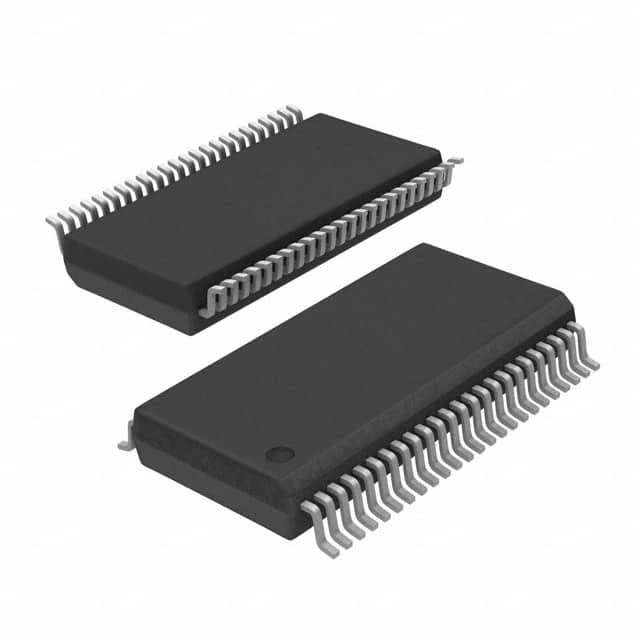Lihat spesifikasi untuk detail produk.

Encyclopedia Entry: 74AVCH16245DGG,518
Product Overview
Category
The 74AVCH16245DGG,518 belongs to the category of integrated circuits (ICs) and specifically falls under the group of digital logic level shifters.
Use
This product is primarily used for voltage level shifting in digital signal transmission between different logic families. It enables seamless communication between devices operating at different voltage levels.
Characteristics
- Voltage Level Shifting: The 74AVCH16245DGG,518 allows bidirectional voltage level shifting between two different voltage domains.
- High-Speed Operation: It supports high-speed data transmission, making it suitable for applications requiring fast signal propagation.
- Low Power Consumption: This IC is designed to minimize power consumption, making it energy-efficient.
- Wide Operating Voltage Range: It can handle a wide range of input and output voltage levels, providing flexibility in various applications.
Package
The 74AVCH16245DGG,518 is available in a surface-mount package. The specific package type is Dual-Gate Gull Wing (DGG), which ensures easy integration onto circuit boards.
Essence
The essence of this product lies in its ability to facilitate voltage level translation, enabling seamless communication between devices operating at different voltage levels.
Packaging/Quantity
The 74AVCH16245DGG,518 is typically packaged in reels or tubes, containing a specified quantity of ICs per package. The exact packaging and quantity may vary depending on the manufacturer's specifications.
Specifications
- Supply Voltage Range: 1.2V to 3.6V
- Input Voltage Range (A Port): 0V to VCCA + 0.5V
- Input Voltage Range (B Port): 0V to VCCB + 0.5V
- Output Voltage Range (A/B Ports): 0V to VCCA/VCCB
- Maximum Data Rate: 400 Mbps
- Number of Channels: 16
Detailed Pin Configuration
The 74AVCH16245DGG,518 features a total of 48 pins, distributed as follows:
- Pins 1-8: A Port (Channel 1-8) Inputs/Outputs
- Pins 9-16: B Port (Channel 1-8) Inputs/Outputs
- Pins 17-24: A Port (Channel 9-16) Inputs/Outputs
- Pins 25-32: B Port (Channel 9-16) Inputs/Outputs
- Pins 33-40: Power Supply and Ground Pins
- Pins 41-48: Control Pins (OE, DIR)
Functional Features
Bidirectional Level Shifting
The 74AVCH16245DGG,518 allows bidirectional voltage level shifting between two different voltage domains. It ensures seamless communication by translating signals from one logic family to another.
High-Speed Data Transmission
With a maximum data rate of 400 Mbps, this IC supports high-speed data transmission, making it suitable for applications requiring fast signal propagation.
Enable and Direction Control
The control pins (OE, DIR) provide enable and direction control functionality. The OE pin enables or disables the outputs, while the DIR pin determines the direction of data flow.
Advantages and Disadvantages
Advantages
- Enables voltage level translation between different logic families.
- Supports high-speed data transmission.
- Low power consumption.
- Wide operating voltage range provides flexibility in various applications.
Disadvantages
- Limited to 16 channels, which may not be sufficient for complex systems requiring a higher number of channels.
- Requires careful consideration of input and output voltage levels to ensure proper operation.
Working Principles
The 74AVCH16245DGG,518 utilizes a combination of MOSFETs and level shifting circuitry to achieve voltage translation. When a signal is received at the input pins, the IC adjusts the voltage levels according to the specified logic family, allowing seamless communication between devices operating at different voltage levels.
Detailed Application Field Plans
The 74AVCH16245DGG,518 finds applications in various fields, including:
- Microcontroller Interfacing: It enables communication between microcontrollers operating at different voltage levels.
- Sensor Networks: Facilitates voltage level translation in sensor networks where different sensors operate at varying voltage levels.
- Industrial Automation: Allows integration of devices with different logic families in industrial automation systems.
- Consumer Electronics: Enables compatibility between devices with different voltage requirements, such as smartphones, tablets, and peripherals.
Detailed and Complete Alternative Models
- SN74AVCH16245DGGR
- MC74AVCH16245DTRG
- 74LVC16245ADGG,518
- CD74HCT245M96
These alternative models offer similar functionality and can be considered as alternatives to the 74AVCH16245D
Sebutkan 10 pertanyaan dan jawaban umum terkait penerapan 74AVCH16245DGG,518 dalam solusi teknis
Sure! Here are 10 common questions and answers related to the application of 74AVCH16245DGG,518 in technical solutions:
Q: What is the function of the 74AVCH16245DGG,518? A: The 74AVCH16245DGG,518 is a 16-bit bus transceiver with direction pin, used for bidirectional level shifting between two voltage domains.
Q: What is the operating voltage range of the 74AVCH16245DGG,518? A: The 74AVCH16245DGG,518 operates within a voltage range of 1.2V to 3.6V.
Q: How many channels does the 74AVCH16245DGG,518 have? A: The 74AVCH16245DGG,518 has 16 bidirectional channels.
Q: Can the 74AVCH16245DGG,518 handle high-speed data transmission? A: Yes, the 74AVCH16245DGG,518 is designed for high-speed operation and can support data rates up to several hundred megabits per second.
Q: Does the 74AVCH16245DGG,518 have built-in ESD protection? A: Yes, the 74AVCH16245DGG,518 incorporates ESD protection on all pins, making it more robust against electrostatic discharge events.
Q: Can I use the 74AVCH16245DGG,518 in mixed-voltage systems? A: Yes, the 74AVCH16245DGG,518 is suitable for mixed-voltage applications as it provides bidirectional level shifting between different voltage domains.
Q: What is the maximum output current of the 74AVCH16245DGG,518? A: The 74AVCH16245DGG,518 can source or sink up to 32mA of current per channel.
Q: Does the 74AVCH16245DGG,518 support hot insertion and removal of devices? A: Yes, the 74AVCH16245DGG,518 is designed to support hot insertion and removal without causing damage to the device or the system.
Q: Can I use the 74AVCH16245DGG,518 in automotive applications? A: Yes, the 74AVCH16245DGG,518 is qualified for automotive applications and meets the necessary standards for automotive electronics.
Q: Are there any specific layout considerations for using the 74AVCH16245DGG,518? A: Yes, it is recommended to follow the layout guidelines provided in the datasheet to ensure proper signal integrity and minimize noise coupling between channels.
Please note that the answers provided here are general and may vary depending on the specific requirements and application context. It is always advisable to refer to the datasheet and consult with the manufacturer for accurate and detailed information.

